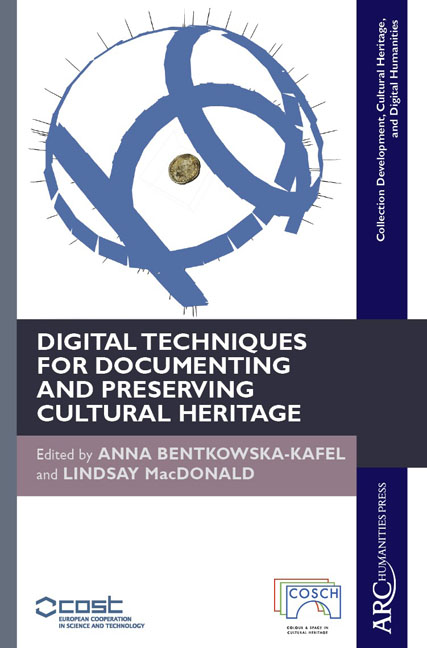3D Laser Scanning
Published online by Cambridge University Press: 26 January 2021
Summary
The COSCH Case Studies that have employed this technology: Roman coins, Germolles, Kantharos, Bremen Cog, White Bastion, Romanian cultural heritage
Definition
Traditional surveying uses point measurements of distance and angles. 3D laser scanning does this, thousands or millions of times per second, by emitting a laser beam onto surfaces and measuring the back-scattered energy. Distance is computed from either time delay or phase-shift measurement. Alternatively, for smaller objects, close-range technologies use triangulation of a sensor and a projected pattern, for example, laser line. Therefore, the surfaces can be represented as a collection of measured points in space; as a result a digital point cloud of the surroundings is created without physically touching the surface. These non-contact optical recording technologies are therefore well suited to heritage applications as they do not disturb historic surfaces. Laser scanning is used at different scales, from small objects less than 10 cm in diameter through to heritage buildings and landscapes.
Description
All 3D laser scanners emit opto-electronic signals; the returned signals are measured. These sensors are often used in combination with a camera to include surface colour measurement. The advantage is the remote—that is, non-contact—recording of surfaces at a high speed with known accuracy. Measured surface data are digitally stored and displayed as a cloud of 3D coordinate points.
The 3D laser scanner may be regarded as the next generation of total station (see separate section), with the ability to record millions of coordinate points rather than hundreds.
Two Different Principles of Recording
Medium or Small Objects – Triangulation Laser Scanning
For small tabletop to medium-sized objects (between ca. 15 cm and 600 cm) a scanhead with a triangulation system (see examples 1 and 2) is used. For the triangulation, a laser beam is projected as a line, and its reflection is measured as distance profile by a camera array. The triangle is formed between a laser line projection, an offset optical sensor with a known baseline to the laser emitter, and object surface, and a known angle for the emitted laser line. The projection of a laser line is produced by widening a single laser beam using a cylindrical lens so that it forms a light curtain on the object's surface.
- Type
- Chapter
- Information
- Publisher: Amsterdam University PressPrint publication year: 2018



